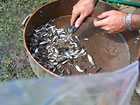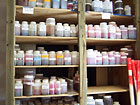

 | |||||||||||||||
|
|
Journals 2005/2006Sarah Mitchell
July 6, 2005 I mentioned that sampling in the tidal creeks needed to take place at low tide, so our work day was determined by this. Taking into account when low tide would be and how long it would take to get to our site we left this morning at about 11:00. Two of the fellows who were in the field yesterday were out today with back trouble so teams were rearranged. To vary my experience, I was sent with the team that worked the order of the creek that was in the marsh, rather than the upland. We drove with some of the DNR crew to a dock that was fairly close to our final destination. There we boarded a small boat that had been brought up yesterday. The DNR crew work from the boat, collecting along the lowest stretch of the creeks. The site my group was sampling today was best accessed by water, and they were kind enough to give us a lift. Unlike the site yesterday that was surrounded by trees, this area is a saltwater marsh, much like the Everglades. For as far as the eye could see, there was spartina and junkus, bordered in the far distance by trees. It's amazing to be just a few miles away from civilization, and yet so far. I imagine that a trained eye could read the landscape better, but it appeared to me there were few distinguishable landmarks, and I was happy we had a GPS to indicate where we needed to go. Having been to this site the previous day, Guy knew that the mud along this creek made for tough walking, so sticking to the high ground for distance was our best bet. To avoid as much of this as possible, we again walked along the junkus line, where the ground was firmer. Our first site today was the farthest upstream where it was very narrow and shallow. In addition to the difficulty of walking through the soft mud, we had to work the net around the clumps of spartina and mud in the creek. The dedication and grit of these scientists was made more apparent to me every day. While it might have been easier to cut the 25m short, or sample a different site, they know the importance of following procedure and protocol. Guy and I did our best to work the seine net here and collected the smallest sample I've seen - a mere three specimens. Our next site was not far down the creek, but the bottom was so soft it was easier to head back up to the junkus line to reach our site. Walking even a short distance here can be quite a challenge. While the grass would get in the way, I couldn't help wondering if snow shoes would help to avoid sinking so much. Working the seine net in this second site brought in a greater catch which was labeled and bagged to be processed at the lab. Tidal creeks and salt marshes are critical aquatic nurseries. Many commercial and recreational species spend time here as juveniles. Identifying our catch is too difficult to do in the field, so everything is bagged and brought back to the lab. While we were gathering our catch and moving it into bags, it was interesting to see how quickly the water drained out of the creek. In the time it took us to clean out the net and get everything in bags, the water disappeared so fast it was as if someone had pulled out the plug. Blue crabs seemed to appear from nowhere and were scrambling all around us. I was very grateful one did not decide I might make a good meal. The netting at the third site today proved to be one of the biggest catches Guy said he has gotten, and I think we missed some at that! The creek was about two meters wider than the net was long, so who knows how much we didn't get. Some fish even jumped over the net! This collection yielded some very large mummichogs, grass shrimp and crabs, as well as some other shrimp species and fish we couldn't identify. Luckily, there are folks back in the lab who can.
We collected the sonde and headed down stream to meet the boat. As the tide had gone out since we were dropped off, we had to go further downstream to meet the boat. At this point I was pretty exhausted and surprised to hear the two I was with say that today was easy compared to yesterday. There were times today where I sank up to my knees with each step, and any forward motion required a great deal of energy. I was starting to learn how to work with the mud rather than against it, but the mud was still winning. To help distribute my weight I sometimes walked on my knees which did prevent me from sinking so much but was definitely tiring. With enough water in the creek at this section, staying in the creek to reach the boat helped cool us off and the deeper we got, the less we sank into the mud. In addition to my backpack I was carrying a bucket which I learned I could use as a float. Holding it upright, I could lean into it which took a lot of my body weight off the bottom. I felt like I was walking on the moon as my feet worked their way through the softer upper layers of the mud and I sort of "bounced" along. The sighting of a gator up ahead brought us a little concern, especially because the water here is so brown. We forged ahead to the designated meeting place and a cell phone call told us we had about fifteen minutes before the boat would arrive. We took advantage of the chance to clean off and stay cool and while we were bobbing in the creek, a skimmer came by in search of food. What a beautiful bird. Today we also saw wood storks, great blue heron, little blue heron, great egret and not to forget, the gator.
|
||||||||||||||


